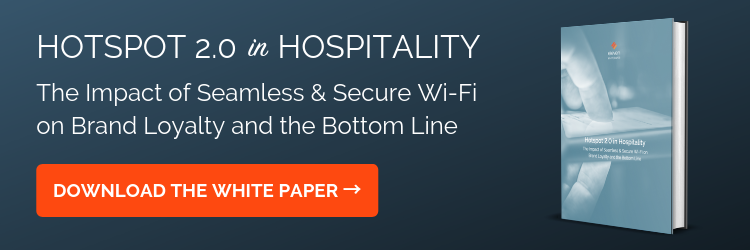
The Wi-Fi Alliance® recently released specifications for release 3 (r3) of Hotspot 2.0. Primarily, this release focused on the Hotspot 2.0 profile’s interaction with networks and aims to streamline the user experience installing the profile. If you want to learn more about the basics of Hotspot 2.0, check out our previous blog post, How Hotspot 2.0 Streamlines Guest Wi-Fi Access.
Each release is a new specification that manufacturers must adhere to in order to ensure their devices are compliant and capable of leveraging Hotspot 2.0. Release 1 (r1) effectively established the basic concepts of Hotspot 2.0, such as the ability to discover Passpoint enabled networks and select the optimal one. Release 2 (r2) was introduced in October 2014 and outlined improvements to r1’s foundation, including the standardization of credential management and the incorporation of an online sign-up (OSU) page to enable intuitive end user device configuration provisioning. Establishing OSU helped spur adoption of Hotspot 2.0 as users who were not technically savvy or familiar with the concept could be directed to the page for a simple, guided profile download.
The r3 specification continues to improve the interaction between end user and operator, refine the user experience, and bolster network communication with the addition of several Access Network Query (ANQP) elements. The addition of a terms and conditions acceptance criteria helps providers secure and maintain liability on their Hotspot network(s). This means that end users may be forced to click through a page running through an operator’s unique terms of agreement in order to download and utilize the Hotspot 2.0 profile. This is a fairly standard process when accessing “public” networks and works to keep both user and operator more secure while on Wi-Fi.
Another upgrade in the user experience department is that ability to set up a single SSID for the OSU page. This allows the end user to identify a single SSID within a possible set in order to retrieve the network’s Hotspot 2.0 profile via the OSU. Nearly everyone has experienced sitting down in a busy public space to access the Internet, and having to search through scores of network names to find the appropriate network to join. Considering the fast adoption of Hotspot 2.0, it is likely people would want to immediately gain access to the OSU to get a profile as quickly as possible. This feature allows an operator to easily call out the SSID (for example, “Hotel Brand Hotspot 2.0”) for the end user to install the profile on their device. Once the profile is installed, they will not need to search for an SSID at that location again.
The specification adds three new ANQP elements. The new ANQP elements are the Operator Icon Metadata, Venue URL, and Advice of Charge elements. The Operator Icon Metadata element simply provides metadata about the Hotspot Operator icon file(s) that are available for download. This should make it easier to display the proper icon image based on the device and context of the use case.
The Venue URL element enables the UI to inform the end user by displaying custom venue information. How this is displayed is dependent upon the operator and implementation. The element helps to isolate from which URL this information can be fetched, and this information can be displayed after a user request or proactively when the device performs other ANQP requests.
When leveraged by an access point advertising the Hotspot 2.0 capability the Advice of Charge element, a mobile device can request “Advice of Charge” information about any charges that are incurred when accessing the hotspot. The additional element provides payment information from the carrier and how to bill the user. This is a likely scenario when accessing a Hotspot 2.0 network at a business, such as a hotel, where there may be local charges to the user for using the service.
It is important to note that the r3 specification, similar to the previous two releases, will take time to be implemented by phone and network device manufacturers. It is likely that this implementation period may take up to 18 months after the release of the specification. As we continue to see releases and further improvements to the Hotspot 2.0 specification, we must be patient as manufacturers will need to stay up to date and ultimately build products to these new requirements.
